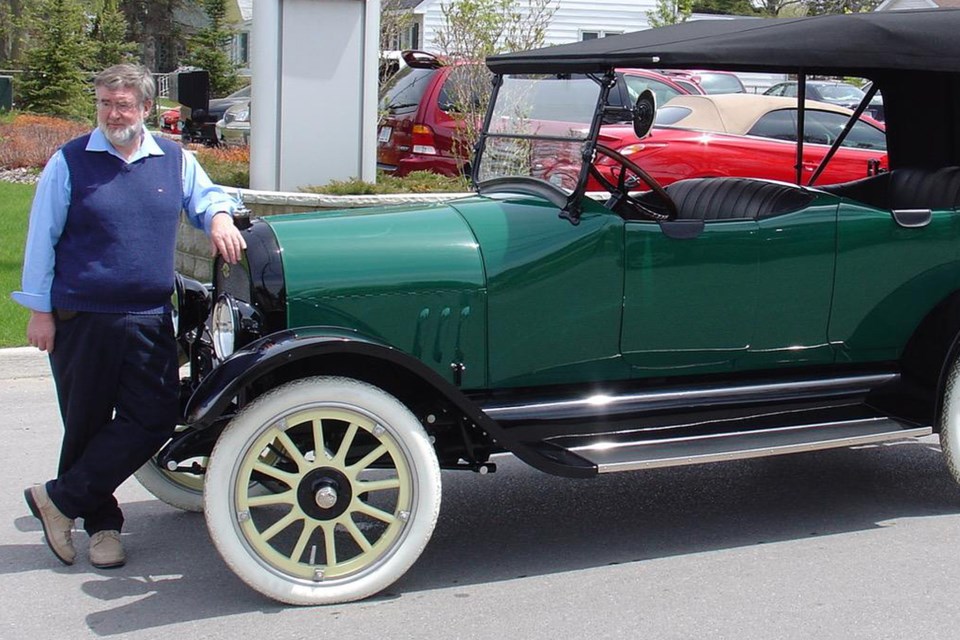A decade-long labour of love reflects the industrial vigour of early 20th-century Barrie.
The Barrie Bell, a five-passenger touring car manufactured at the Barrie Carriage Company in 1917, was merely a shell of its original self when Brian Jackson came across it in the 1990s.
But with the help of then-mayor Janice Laking — and a group of equally enthusiastic supporters — Jackson put his nose to the grindstone and refurbished the Bell.
The volunteer-driven Barrie Bell Restoration Committee found support from local businesses and residents, he says.
“It’s an important part of the development of the city of Barrie,” he says of the Barrie Carriage Company. “It reflects the goals of many municipalities in the province at that time as they moved into the industrial age. The company was significant in Canada and to make the change from horse carriages to horseless carriages was a major move.”
While still manufacturing wheeled creations powered by four-legged muscle, in 1915 local businessman Simon Dyment began negotiations with the fledgling Bell Motor Car Company of York, Pennsylvania to assemble the lightweight Bell automobile in Barrie, according to local historian Brad Rudachyk.
“To finance this new venture, Dyment is reputed to have borrowed heavily using family holdings as collateral,” he says. “Assembly is reported to have begun at Barrie in 1916.
"The company displayed its Club Roadster and standard touring car at the Toronto Exhibition in 1917.”
Contracts for 300 vehicles were in place for the coming season, but by 1918, the company was in deep trouble, Rudachyk says.
“Sadly, the Bell venture proved to be the undoing of both the company and the Dyment fortune. Nonetheless, between 29 and 40 Bell automobiles were assembled in Barrie before the Barrie Carriage Company works fell silent in April 1920.”
The three-storey carriage works, situated on the northeast corner of Ellen and John streets near Lakeshore Drive and long since demolished, were “a hub of industry," he adds.
The Bell roadster Jackson came to know and love so well was No. 29 coming off the line.
“When we were restoring the doors, someone had chiselled that on the seat frames,” he says from his home in Thornton.
The former Innisfil mayor has fond memories of the big work involved with the Bell’s restoration.
“Aside from getting the funding in place, the biggest challenge was the authentic parts for the restoration, specifically the transmission and motor for the vehicle,” Jackson says. “They are authentic to the vehicle and similar to the ones that were produced in the United States (at the Bell Manufacturing Company) in York, Pennsylvania.
“Back so many years ago, people would decide to build a car and they’d grab a fender here, and a motor here and a headlight there,” he says. “The Bell company didn’t build their own parts. They bought parts and assembled them. The fenders on that car looked quite similar to other cars from the same era.”
Members of the restoration committee included chairman Jackson, vice-chair Rudachyk, Laking, honorary fundraising chair Robert Keto, Harris Steele, Robert Bourne, John Poole (director of technical services), and Murray Irwin (who, along with Jackson, was a technical team leader and whose grandfather owned the vehicle back in the day). Douglas Hill and David Aves rounded out the team.
“Murray and I spent thousands of hours — and our own money — travelling across southern Ontario and the United States gathering parts,” Jackson says. “The muffler for the Barrie Bell came from Chickasha, Oklahoma.
“It took over 10 years from the time we started on the car to get it completed and donated to the city of Barrie. We worked on it every week for 10 years.”
The car is currently in storage at the Simcoe County Museum.
The Barrie Bell is one of two Bell automobiles left in the world today, Rudachyk says.



